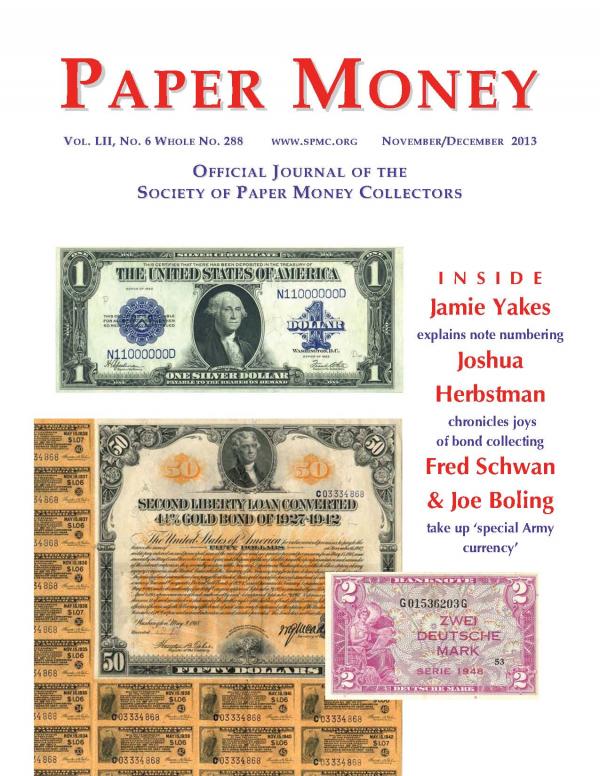Please sign up as a member or login to view and search this journal.

Table of Contents
FEATURES
The Rebel Who Issued Obsolete Currency . . . . . . . . . . . . . . . 403
By Richard Frey
The Paper Column: Salvaged Plates . . . . . . . . . . . . . . . . . . . . .427
By Peter Huntoon & Jamie Yakes
Joys & Frustrations of Collecting U.S. Treasury Bonds . . . . . 408
By Joshua Herbstman
Design Changes of Johnson House Merchant Scrip . . . . . . . 418
By Bill Gunther
Did New Jersey Have Private Banks? . . . . . . . . . . . . . . . . . .438
By David D. Gladfelter
Chasing Information for Numismatic Research . . . . . . . . . . . 442
By Greg Davis
The Paper Column: Evolution of Title Blocks on 1929 NBNs .447
By Peter Huntoon & Lee Lofthus
Detecting Enhanced Notes . . . . . . . . . . . . . . . . . . . . . . . . . . 451
By Jeff Sullivan
Bank Difficulties in Putnam County . . . . . . . . . . . . . . . . . . . 462
By Ed Galligan
The Buck Starts Here: Odd Denomination Notes . . . . . . . . . . . . . 460
By Gene Hessler
Small Notes: Recycled 1928D Chicago $10 Plates . . . . . . . . . 461
By Jamie Yakes
SOCIETY & HOBBY NEWS
Can anyone help out a past SPMC President? . . . . . . . . . . . . . . . . . . . . . . .426
New Members . . . . . . . . . . . . . . . . . . . . . . . . . . . . . . . . . . . . . . . . . . . . . . . .433
Paper Money editor Fred Reed releases Civil War Stamp Envelopes . . . . .453
President’s Column by Pierre Fricke . . . . . . . . . . . . . . . . . . . . . . . . . . . . . . .454
Uncoupled: Paper Money’s Odd Couple by Joseph E. Boling & Fred Schwan . .456
Money Mart . . . . . . . . . . . . . . . . . . . . . . . . . . . . . . . . . . . . . . . . . . . . . . . . . . .455
First Call: George W. Wait Memorial Prize Announcement . . . . . . . . . . . . . . . .475
Draft of SPMC Revised Book-Publishing Policies . . . . . . . . . . . . . . . . . . . . . . .478
Back of the Back Page by Loren Gatch & Fred Reed . . . . . . . . . . . . . . . . . . . .479
The Back Page with Paul Herbert and YOU . . . . . . . . . . . . . . . . . . . . . . . . .480
Tweet
More like this
- Paper Money- Vol. LIII, No. 6- Whole No. 294- November/December 2014
- Paper Money- Vol. LIV, No. 6- Whole No. 300- November/December 2015
- Paper Money- Vol. LV, No. 6- Whole No. 306- November/December 2016
- Paper Money- Vol. LVI, No. 6- Whole No. 312- November/December 2017
- Paper Money- Vol LVII, No. 6- Whole No. 318- November/December 2018

